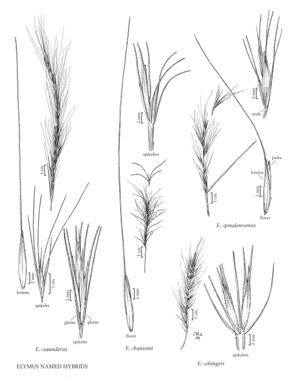Elymus ×ebingeri
Plants cespitose, not rhizomatous. Culms 50-135 cm, usually smooth, glabrous, sometimes retrorsely hairy; nodes glabrous or hairy. Leaves evenly distributed; sheaths smooth or scabridulous, hairy; ligules to 1 mm; blades 14-26 cm long, to 12 mm wide, flat, both surfaces scabridulous, adaxial surfaces hairy. Spikes 8-17 cm, with (1)2+ spikelets per node; internodes 4-8 mm. Spikelets diverging at about 45° from the rachises, not patent. Glumes usually subequal, 15-20 mm, bases indurate, bodies lanceolate to subulate, scabrous, sometimes the lower glumes reduced to a stub; lemmas 8-10 mm, glabrous or strigose, sometimes scabrous, awns 23-29 mm, straight, scabrous; anthers 2-2.9 mm. Caryopses seldom formed.
Distribution
N.Y., Conn., Ill., Ind., Mo., Wis., Ont.
Discussion
Elymus ×ebingeri is the name for hybrids between E. virginicus (p. 298) and E. hystrix (p. 316). It is frequently found where the two parental species grow together, often with later hybrid generations and introgressants to the two parents. It has been reported from southern Ontario, and from Wisconsin to New York and Illinois. Most published reports simply refer to the existence of these hybrids, the name itself not having been published until 1996.
Elymus ×ebingeri is an Elymus named hybrid
Elymus is notorious for its ability to hybridize. Most of its interspecific hybrids are partially fertile, permitting introgression between the parents. The descriptions provided below are restricted to the named interspecific hybrids. They should be treated with caution and some skepticism; some are based solely on the type specimen, because little other reliably identified material was available. Moreover, as the descriptions of the non-hybrid species indicate, many other interspecific hybrids exist.
The parentage of all hybrids is best determined in the field. Perennial hybrids, such as those in Elymus, can persist in an area after one or both parents have died out, but the simplest assumption is that both are present. Interspecific hybrids of Elymus that have disarticulating rachises presumably have E. elymoides or E. multisetus as one of their parents.
Selected References
None.
